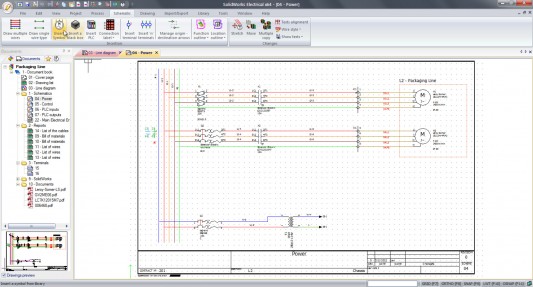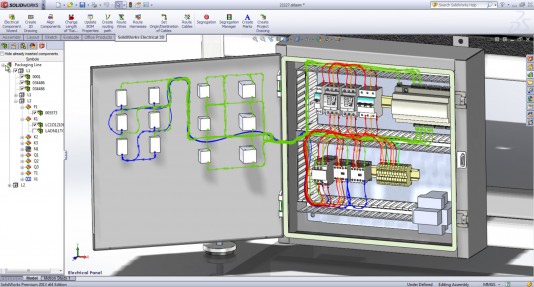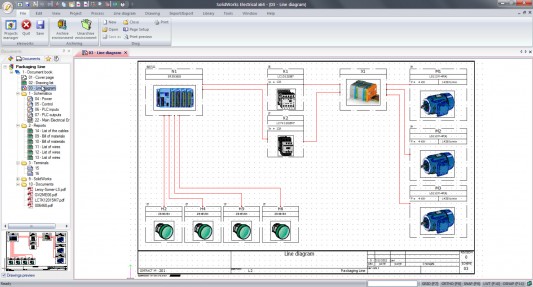Steve Wolfe explores the history and capabilities of the market-leading AutoCAD Electrical with a new competitor from SolidWorks.
[Editor’s Note: This is Part 2 of Steve Wolfe’s report on SolidWorks Electrical. Links to the other articles in this series are at the end of this article. In part 1 Steve explored the history of both products.]
By L. Stephen Wolfe, P.E.
Dassault Systèmes SolidWorks announced SolidWorks Electrical in September 2012 simultaneously with the release of SolidWorks 2013. There are three software packages in the family.
- SolidWorks Electrical helps engineers design 2D schematic diagrams and wiring drawings. It includes a library of 500,000 electrical components and manages the schematic netlist using a relational database. The US list price is $5,995 plus $1,695 annually for subscription updates and dealer support. No SolidWorks CAD license is required.
- SolidWorks Electrical 3D is an add-in application for SolidWorks that enables wires and wiring harnesses to be routed in a semi-automated fashion though a SolidWorks model. The US list price is $5,995 plus the cost of a SolidWorks license. Annual maintenance is $1,695.
- SolidWorks Electrical Professional combines the capabilities of both products in a single license. It competes with Autodesk’s Product Design Suite Premium. The US list price is $9,995 plus the cost of a SolidWorks license and $2,750 per year for maintenance.

Neither the 2D nor 3D versions of SolidWorks Electrical are new. Trace Software has been selling both versions to SolidWorks customers under the trade name “Elecworks” for about five years according to a Trace Software representative. Both products employ a private-label version of CAD software from Gräbert, the German company that supplies Dassault Systèmes with its DraftSight software. Gräbert’s software stores graphical information in the DWG format used by AutoCAD. But there’s more to the electrical software than just a drawing.
SolidWorks Electrical 3D supersedes Trace Software’s elecworks 3D. Elecworks 3D customers under maintenance will automatically receive the SolidWorks product on its next release. SolidWorks 3D builds upon the 3D wire- and cable-routing capabilities that have been included in SolidWorks Premium for years. However, customers no longer need to buy SolidWorks Premium in order to enjoy the 3D electrical capabilities.
SolidWorks has improved the user interface of Elecworks to make SolidWorks Electrical more consistent with other SolidWorks software. It has also added support for languages not previously supported by Trace Software.
Noteworthy Features
Elecworks (and SolidWorks Electrical) store symbols and wire lists in Microsoft’s SQL Express, a relational database that comes with the package at no extra charge. The database enables information on schematic diagrams to be synchronized with physical wiring drawings or 3D wiring models stored in SolidWorks.
Most engineers still draw schematics and physical wiring drawings with plain drafting programs. This method is prone to error because it’s hard to assure that the topology of the physical wiring drawing or wire harness drawing agrees with the electrical schematics that define the functions of the system. If the physical wiring doesn’t agree with the schematic, the system won’t work properly. Incorrect wiring causes more product defects than incorrect mechanical design.
Programs such as SolidWorks Electrical and AutoCAD Electrical reduce errors by assuring that physical and logical wiring drawings agree. Errors such as shorts, wiring to incorrect terminals, duplicate use of wire numbers or reference designators, and duplication of relay contacts are some of the most common errors that integrated electrical design software can catch.

Electrical software also speeds the drafting of schematics and wiring diagrams in several ways. Electrical symbols may be recalled from a library and placed on the drawing in one operation. When inserting a component in a circuit, the software automatically breaks the line and connects it to the proper connection points on the symbol. Reference designators and contact numbers can be assigned automatically.
An exceptional feature of SolidWorks Electrical is the ability to design using single-line diagrams and then create associated multi-line diagrams as the schematic details develop. The single-line and multi-line diagrams remain associated, so that changes to one are reflected in the other.

A second great feature is the ability to copy whole sections of a circuit, such as an electric motor, and paste an additional circuit into the schematic. The software will reassign part numbers and wire numbers to the diagram automatically if desired.
Costs and benefits
The productivity gains of electrical software are partially offset by higher costs. These include higher initial license and annual subscription fees for the software. Training of engineers in how to use the software and administrators in how to set it up and maintain it also adds cost. Formal procedures must be devised that require engineers to add new parts to the system library before using them in designs. And database software must be set up for sharing by all electrical engineers in the company.
All the components required by any company’s business probably won’t be included in the library that comes with the software. So library symbols must be created before the system can be used. SolidWorks Electrical has four types of symbols: those for single-line schematics, multi-line schematics, 3D wiring models, and 2D wiring drawings.
A second consideration for buyers of electrical design software is whether to employ 3D models for physical wiring or make two-dimensional wiring drawings. Wiring diagrams for electrical switchgear and control panels are usually faster to design with 2D drawings. But wiring that snakes through vehicles, industrial machines, or complex plants may be faster to design in 3D. The 3D system automatically calculates the correct length of each wire. Wiring harnesses information can automatically be extracted from the 3D model to produce assembly drawings. Firms that design with 2D wiring diagrams need not purchase SolidWorks Electrical 3D. The base SolidWorks Electrical software allows drafting of wiring drawings and harnesses.
Because of the higher initial costs, electrical design software only makes sense for companies that are creating many similar designs using a common component library. Such organizations might include makers of electrical switchgear and control systems, industrial machinery, aircraft, land and waterborne vehicles, laboratory and medical instruments, and industrial plants. Firms engaged in contract work for multiple clients may have trouble justifying the cost of electrical software unless they perform repetitive design work for a narrow set of clients.
GraphicSpeak Managing Editor Randall S. Newton contributed research for this article.
[Editor’s Note: This ends Part 2 of Steve Wolfe’s report. Links to the other articles in this series will be added here when all three are online.]
Part One: https://gfxspeak.com/?p=12894





